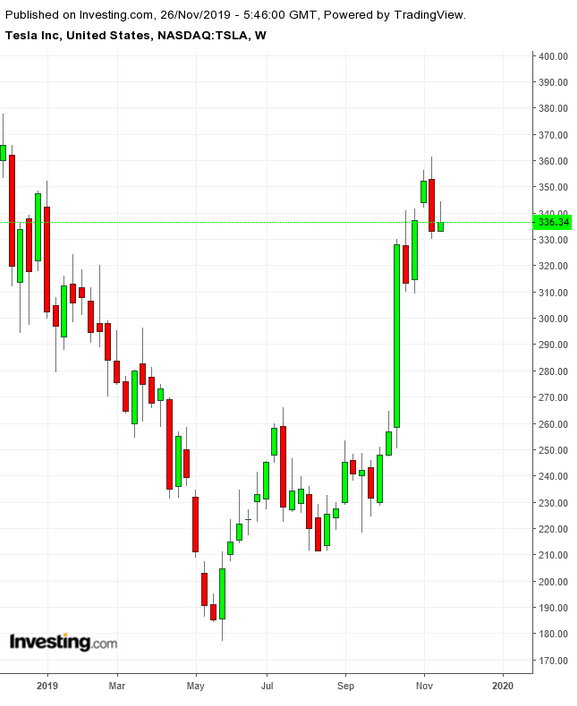This article is Part 9 of an 11-part series analysis of Tesla, Elon Musk and EV Revolution. You can read other parts here.
Elon Musk is unlike any leader we’ve ever seen. For most people, building PayPal (NASDAQ:PYPL) would have been an incredible achievement. Not for Musk; he built Tesla (NASDAQ:TSLA), a vertically integrated car company and the first new U.S. car company to survive this long since 1930.
But Tesla is not just a car company that is on its way to producing a few hundred thousand electric cars a year. It is a company building a charging network that covers not just the U.S. but Western Europe and parts of Asia. It’s a company that designed a self-driving processor for its own cars. I can keep going, and I will. Elon also built SpaceX, a company that is able to send rockets into space at a 10x lower cost than NASA – and land the rockets back on a barge parked in the middle of the ocean.
He is working on a company, Neuralink, that wires your brain to a computer. OK, I’ll stop. I’d argue that even if Tesla goes bankrupt tomorrow, Elon has succeeded – he has accelerated human progress decades into the future.
Elon Musk (along with Tesla stock) is polarizing in the investing community. He sets impossible goals and achieves half of them several years late. The other half he either will not achieve or just hasn’t achieved yet – we don’t know. There appear to be two motivations behind his seemingly unrealistic goals. On one side, just like Steve Jobs, he has created a reality distortion field and convinced people with his charisma and confidence that they can achieve seemingly unachievable dreams.

But there is another side to Musk.
Tesla has lost money every year of its existence. There is nothing wrong with this, considering that Musk has created a vertically integrated company in an industry that did not exist 10 years ago. The problem is that these losses have to be financed, and they can be financed by either debt or equity. A company that is losing money has a limited capacity to borrow because it has a limited ability to even pay interest on that debt. Therefore, it has to finance its losses by issuing equity.
Tesla is not trading on a multiple of today’s or even tomorrow’s earnings; it is trading on a multiple of Elon Musk’s dreams. At times, Tesla, which manufactured 245,000 cars in 2018, has had a greater market cap than General Motors (NYSE:GM), which produces almost 10 million cars a year. The bigger the dreams, the larger the company’s market cap and the easier it is for Tesla to finance its losses … and to achieve Elon Musk’s dreams. But distinguishing which dreams will turn into realities is incredibly difficult, not just because of the physical attainability of those dreams but because to achieve them Tesla will need more capital.
So, to project whether Tesla will achieve Musk’s big dreams, you need to have an opinion not just on their attainability but on the question of whether others will have faith in Tesla and Musk long enough to allow the company to issue cheap equity to finance those dreams. Every so often, to keep the dream valuation going, Musk makes an announcement that seems to defy what we believe is possible today.
In May 2019, Musk announced that he was expecting a network of Tesla robo-taxis to be operating by 2020. Even if Musk is wrong by two years and this ambitious dream comes true in 2022, it will transform the auto industry and turn Tesla into a cash cow (while also putting Uber (NYSE:UBER) and LYFT (NASDAQ:LYFT) out of business, unless they come up with their own robo-taxis by then). Or does the robo-taxi belong to a category of sci-fi dream that may or may not be feasible even by 2030?
Before you answer this question, let me give you two more examples.
In July 2017, Musk announced that Tesla was ready to take orders for solar roofs, implying that the technology was ready for prime time. Two years on, after consumers have put down deposits, little more has been heard about solar roofs. Maybe we should have taken Musk literally, not figuratively – Tesla was ready to take orders (but the roof was not ready).
Another example. In his 2016 shareholder letter, Musk wrote that he expected Model 3 production in the fourth quarter to hit 5,000 cars a week (260,000 cars a year). Now imagine you are in the fourth quarter of 2017 and Tesla is producing 186 cars a week (about 9,700 a year). Did Musk lie to you, or did he just dream big but fall short of that dream (so far)? Well, would you believe Musk’s next promise, to produce 500,000 Model 3s in 2018 – a 50x increase?
Let’s skip 2018 and fast-forward to 2019, where in the second quarter we find Tesla producing at an annualized pace of 288,000 cars and on its way to reach the 500,000 annual production run rate by late 2019 or so.
Given these facts, when Musk makes a forecast, what is plausible and what is exaggeration? How do we know?
These examples illustrate a few points:
1) Some of Musk’s promises cross into the unpalatable territory of exaggeration. (Are they really lies if they happen five or 10 years late?)
2) Even promises that Musk will deliver on will come a year or three late.
3) Looking at the past few quarters brings little value when analyzing Tesla. (We have a hard time processing 50x increases in production, even if they come a year later than promised.) Just remind yourself that this is the same person who was able to accomplish things that NASA could not.
To make things more complicated, there are external factors like interest rates, the economy, and trade wars, any of which could cripple Tesla’s valuation, thus making the company’s financing a lot more expensive or completely undoable. In other words, Tesla is a path-dependent company: Its success will depend in part on factors that are completely outside of its control.
This is just one out of 11 parts of my analysis of Tesla , Elon Musk, and the EV revolution.
Disclosure: Vitaliy Katsenelson is CIO at Investment Management Associates; His investment strategy is spelled out here.
